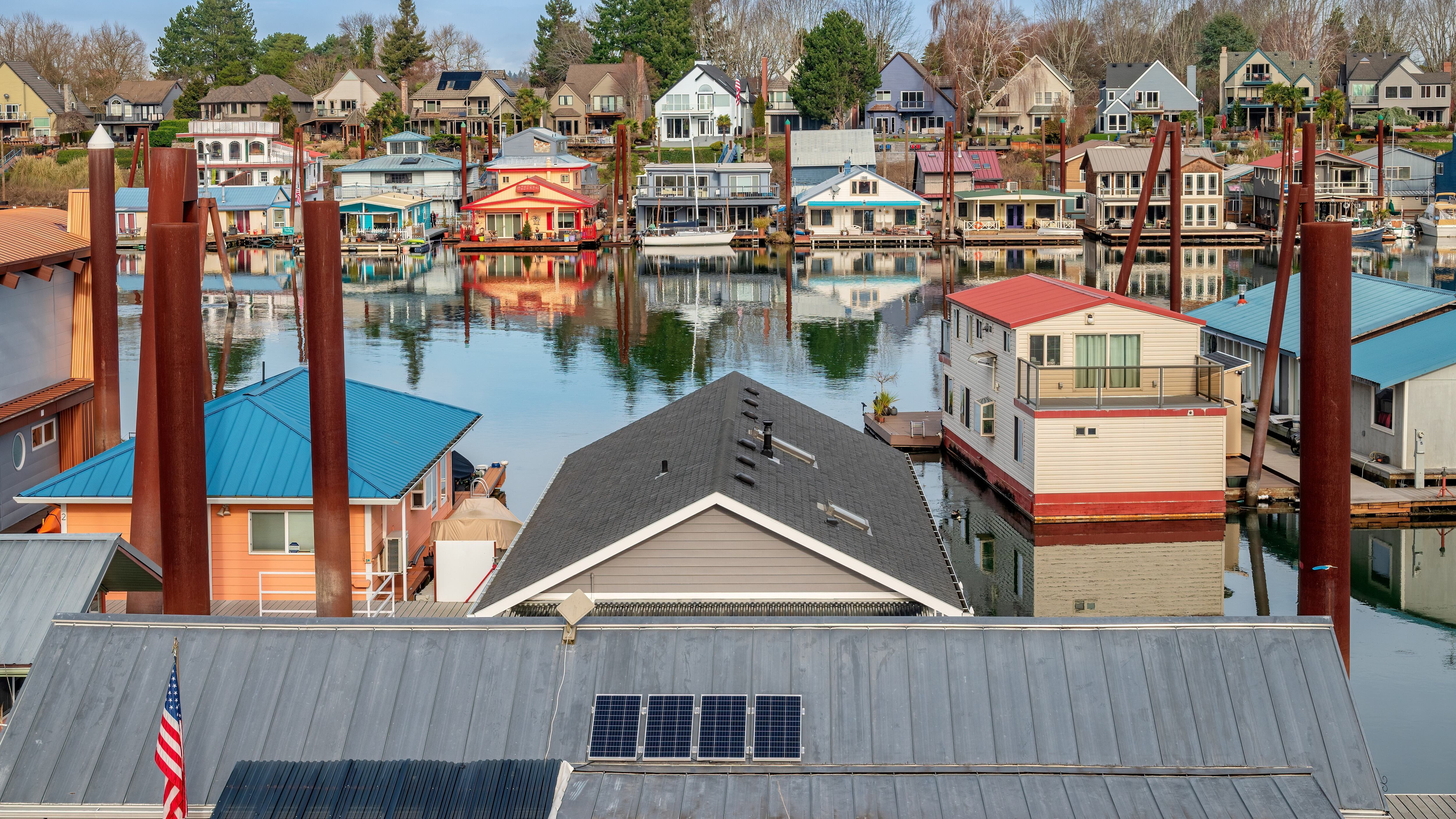To hear the city of Portland tell it, proposed changes to how we pay to deal with stormwater are going to be terrific because a lot of people are going to pay less.
People who live in floating homes have another take. They call the changes a “rain tax.”
There are only about 650 floating homes in Portland, but their opposition is turning a ho-hum “rate case,” as these processes are known, into a battleground.
If you pay a water bill in Portland, you pay to keep the rain that falls on roofs, driveways and streets from overflowing our sewers and running into our rivers. That’s important because stormwater picks up filth and chemicals as it runs down these non-permeable surfaces.
The city’s Bureau of Environmental Services wants to change the formula for stormwater. Right now, residents are billed about the same, regardless of the size of the solid surfaces around their houses. Under the new formula, people in smaller dwellings would pay less. BES also wants to charge more for stormwater and less for sewer because the cost of coping with stormwater has risen, thanks to massive projects like the Big Pipe (which kept stormwater out of the rivers during Sunday’s torrential rain storms, as this tracker shows).
One small plank in the new plan proposes charging floating homes for the stormwater that runs off their roofs and overriver walkways and into the river, even though it takes no city infrastructure to get the water from roof to river. The plan has water dwellers up in arms.
“Stormwater is all about water that can’t soak into the earth,” says Tim Gorman, 61, whose home floats in the Columbia just east of the Interstate Bridge. “We pay stormwater fees because we have parking lots. Why would someone charge me a tax for rain that hits my roof and hits the water?”
Gorman, who bought his house in July 2020, says his monthly stormwater bill is going to rise to $20 a month from $2, a tenfold increase.
That may not sound like a lot, but floating-homeowner George Whitney says many of his neighbors aren’t exactly living Jimmy Buffett’s best life. He paid $210,000 for his one-bedroom, one-bath house in October 2020, far less than even one-bedroom apartments sell for now.
“There are a lot of people on Social Security out here,” Whitney, 56, says.
The new stormwater rates were supposed to go before the City Council on Oct. 18. Gorman and other water dwellers met with City Commissioner Mingus Mapps and BES director Dawn Uchiyama on Oct. 6. Soon after, the rate case disappeared from the council agenda. It was rescheduled for Nov. 8, but was removed again on Friday.
“Commissioner Mapps’ office pulled the item from the upcoming council agenda pending further discussions with constituents,” BES spokeswoman Diane Dulken said in an email. Mapps’ office didn’t immediately return an email seeking comment.
The city says floating homes should pay more in part because projects like the Big Pipe benefit them, too, in terms of flood control beyond their houses.
“We’re billing people for the use of the broader system,” BES program manager Aaron Abrams says. “The bill is for services like making sure the grocery store stays open and isn’t flooded.”
Also, rain that hits roofs, no matter where they are, can leach away heavy metals and hydrocarbons, the city says on a webpage detailing the changes.
“Runoff from metal roofs has also been found to contain high concentrations of copper and zinc,” the city says. “Without treatment, roof runoff can be a source of stormwater pollution that can harm fish and other aquatic life.”
BES is adding decks and walkways around floating homes to the bills because “wood, metal or composite materials can leach pollutants and introduce microplastics and chemical compounds into waterways as they break down over time.”
Gorman, for one, wants to know if landlubbers, too, are going to be billed for their decks.
BES has tried to boost stormwater fees for boat people before. Robin Smith, 65, remembers it. She has lived at the Tomahawk Island Moorage for 13 years. Like most moorages, Tomahawk is a homeowners association that charges dues and pays fees from a pool of money. In 2015, the city started charging her HOA for stormwater coming off the 72 roofs in her community.
“All of a sudden, out of the blue, we got this huge bill,” Smith says. The change meant Tomahawk would have to pay another $20,000. “When your budget is $200,000, that’s a lot of money.”
River dwellers protested, as did Vigor Industrial, a company that repairs ships on a vast dry dock on the Willamette River. Vigor’s argument turned on the definition of an “impervious area” as one that didn’t let stormwater percolate into the ground, according to BES. If a structure is over the water, there is no ground for water to percolate into, Vigor argued.
A code hearings officer agreed. BES tried to revise the definition, but in 2018, three years after the fight began, the City Council declined to vote on it. Instead, it instructed BES to conduct a rate study. In the meantime, the council said, overwater structures would be exempt. Ratepayers, including Vigor and Smith, got three years of fees refunded, BES says.
“We fought them for three years, and they refunded all that money by giving us a credit on stormwater fees for several years,” Smith says.
BES got on with the rate study as the council instructed, paying a company called Galardi Rothstein Group $350,000 to do it. Galardi Rothstein made five recommendations, including cutting rates for people who live in smaller dwellings, charging less for sewer and more for stormwater, and billing floating homes for their roofs and walkways.
“By discharging directly into receiving waters, overwater structures have the potential to significantly impact water quality, and they are among the most benefited properties from upstream flood and water quality controls,” Galardi Rothstein wrote to BES in September.
Smith was surprised to see that the issue had returned to the council’s agenda in October and that the city was trying once again to charge Tomahawk Island Moorage a “rain tax.” It already pays stormwater charges on its parking lot, which holds 100 cars, and on other areas.
“We thought this was gone,” Smith said. “A lot of people who live on our moorage are women who live alone. When you’re on a fixed income, fees like this matter.”
Smith says the city’s argument about pollution is specious. When silt builds up, as it does at many locations on the river, the area under Tomahawk must be dredged. The “spoils,” as they’re known, are tested for contaminants before they can be dumped on land. Tomahawk, she says, has never gotten a bad dredge report.
“If our stormwater pollutes, prove it,” Smith says.
Smith and her fellow residents in floating homes say they will be listening when the stormwater rate case comes before the Portland City Council, whenever that may be.

